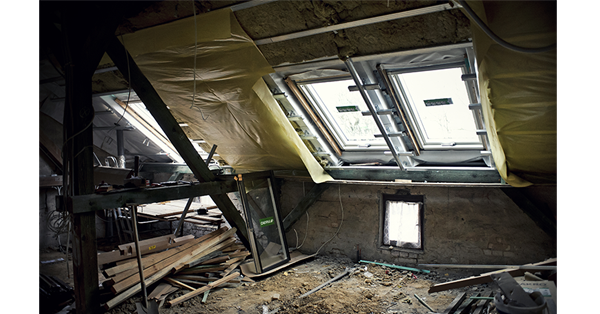Should I Buy a House With Condensation in Loft Space?
- Condensation in a loft space can seem minor initially but might end up dangerous in the long term. Mould growth and constant condensation could lead to structural damage and insulation issues.
- Top Tip: Condensation, damp, and mould growth can devalue a property. Get a house survey before purchasing, even if you have seen no signs of condensation in the loft.
- You can use the surveyor’s report to negotiate the asking price with the seller.
- If you already have loft condensation as a homeowner make sure to invest in better ventilation, insulation, and moisture control.
Condensation in the loft can be a real headache. If you’re thinking about buying a house with this issue, you’re probably wondering just how serious it is and what you can do about it. Let's break down everything you need to know, from the causes and warning signs to the potential risks and solutions.
What is condensation?
Condensation occurs when moist, humid air meets a cooler surface, causing the moisture in the air to turn into water droplets. It’s a common problem in many UK homes, particularly during the colder months.
You’ll often find condensation on windows, walls, and in loft spaces. In the loft, it can form on the underside of the roof, on insulation, or even on stored items. This can lead to a host of issues, including damp patches, mould growth, and structural damage if not addressed promptly.

Condensation might seem a minor inconvenience, but it can cause significant damage over time. This includes:
- Damp and mould: Persistent dampness can lead to mould growth, which is unsightly and can cause health problems.
- Structural issues: Condensation can lead to timber decay and weakened structures.
- Insulation damage: Wet loft insulation is less effective, reducing your home's energy efficiency and leading to higher heating bills.
Has your surveyor confirmed damp?
Your SAM surveyor will flag whether the condensation problems are cause for concern and might recommend our Damp and Timber survey if further investigation is required.
If you have clear signs of moisture or rot, we can arrange a specialist Damp and Timber survey within the week*.
What causes condensation in a loft?
Understanding the root causes of loft condensation is crucial. Here are some of the most common culprits:
Incorrect insulation fitting
Proper insulation keeps your home warm, but if it’s not fitted correctly, it can trap warm air and moisture in your loft.
Gaps in insulation: Gaps or poorly laid insulation can allow humid air to reach the cold surfaces of the loft.
Compressed insulation: Insulation that’s been compressed or is too thin won’t work effectively, leading to condensation build-up.
Poor ventilation of warm air
Ventilation is key to preventing condensation. Without it, warm, moist air from the house can rise into the loft and get trapped.
Blocked vents: Vents can become blocked by debris or insulation, preventing proper airflow. Some lofts don’t have enough vents to allow for sufficient airflow.
Lack of ventilation systems: In some cases, especially in older homes, there might not be any ventilation systems.

Water tanks in the loft
Many UK homes have water tanks housed in the loft or roof space. These can contribute to condensation issues if they are not properly insulated.
Hot water tanks: These can generate a lot of moisture, especially if they’re not covered or have adequate ventilation.
Cold water tanks: Even cold water tanks can contribute if they’re not properly sealed and insulated.
Warning signs to watch out for
Spotting the signs of condensation early can save you trouble down the line. Here’s what to look out for:
Damp patches
Damp patches on insulation, rafters, or walls of the loft are a clear sign of condensation issues. These patches may be wet to the touch and can vary in size.
Mould and mildew
Mould growth on timber, insulation, or other surfaces is a sign of moisture-laden air. It’s not only unsightly but can also pose health risks.
Water droplets
Finding water droplets on the inside of the roof vents, insulation, or storage boxes indicates that condensation is occurring.
Musty smell
A musty or damp smell in the loft often accompanies condensation. If your loft has a persistent odour, it’s worth investigating further.

Peeling paint or wallpaper
Peeling paint or wallpaper on the ceilings or walls beneath the loft floor can signal moisture problems from above.
Cold spots
Cold spots in the loft or rooms below can indicate areas where insulation is failing or where moisture is accumulating.
How serious is loft condensation?
You can’t afford to ignore loft condensation. Over time, persistent condensation problems can lead to serious structural issues and health risks. It can affect your property’s energy efficiency too.
Fungal decay
When relative humidity stays high (above 70-80%), it creates the perfect environment for fungal decay.
- Spread: Fungal decay can quickly spread, causing extensive damage to timber and other materials.
- Damage: This can lead to serious structural problems and necessitate expensive repairs.
Structural damage
- Timber: Wet timber becomes soft and eventually rots through fungal decay, compromising the structural integrity of your roof.
- Weakened roof structures: Prolonged exposure to moisture can weaken the entire roof space including the roof tiles, leading to costly repairs or even failure.
In our recent survey, 16% of homeowners found defects; including 2% who were able to pull out of a bad purchase, 7% who were able to negotiate a better price, and sadly, 7% of homeowners who did not get a survey and discovered defects after the purchase.
12 of the 39 who remembered how much these defects cost to remedy spent over £5,000
Don't burn your money, book a survey.

Health risks
Mould and mildew can pose significant health risks, particularly for those with respiratory conditions or allergies.
- Respiratory issues: Prolonged exposure to damp air and mould can lead to asthma attacks, allergic reactions, and other respiratory problems.
- Allergies: Mould spores can trigger allergic reactions, causing symptoms like sneezing, coughing, and itchy eyes.
Energy efficiency
The ideal indoor relative humidity is between 40-60%. When it rises above this, you’re likely to experience condensation issues.
- Insulation effectiveness: Wet loft insulation is less effective, leading to higher heating costs as your home loses heat.
- Heating bills: Increased energy bills as your heating system works harder to maintain a comfortable temperature.

How to stop condensation in your loft
Addressing condensation in the loft requires a combination of improving natural air circulation, insulation, and moisture control.
Improve air circulation
Install vents: Ensure enough loft vents in the roof and walls to allow for proper airflow. Soffit vents, ridge vents, and gable vents can all help.
Mechanical ventilation: Consider installing mechanical ventilation systems, like extractor fans, if natural ventilation isn’t sufficient.
Clear blockages: Regularly check and clear any obstructions in your air vents to ensure they’re working effectively and improve ventilation.
Insulate correctly
Check for gaps: Make sure insulation is fitted snugly without gaps where warm air can escape.
Avoid compression: Don’t compress insulation, as this can reduce its effectiveness and trap moisture.
Insulate tanks: Ensure water tanks in the loft are well-insulated to prevent humid air from rising and condensing.
Remove moisture
Extractor fans: Install extractor fans in kitchens and bathrooms to remove moist air at the source.
Dry clothes outside: Whenever possible, dry clothes outside or use a tumble dryer that vents outside. Drying clothes indoors could lead to a condensation problem.
Use a dehumidifier: A dehumidifier can help remove excess moisture from the air, especially during the colder months.
Regular inspections
Seasonal checks: Inspect your loft and roof vents at least twice a year, especially after heavy rain or during periods of high humidity.
Look for damage: Look for signs of wear and tear on insulation, roofing materials, roof tiles, and ventilation systems.

Should you buy a house with condensation in the loft?
It isn’t necessarily a deal-breaker for a house purchase, but you do need to consider the following:
- Assessment: Have a professional assess the extent of the condensation and the potential damage.
- Negotiation: Use the findings to negotiate the purchase price, factoring in the cost of necessary repairs and improvements.
- Plan for repairs: Prepare to invest in improving ventilation, insulation, and moisture control to address the issue.
Jack is our resident Content Writer with a wealth of experience in Marketing, Content, and Film. If you need anything written or proof-read at a rapid speed and high quality, he's your guy.
Caragh is an excellent writer and copy editor of books, news articles and editorials. She has written extensively for SAM for a variety of conveyancing, survey, property law and mortgage-related articles.









